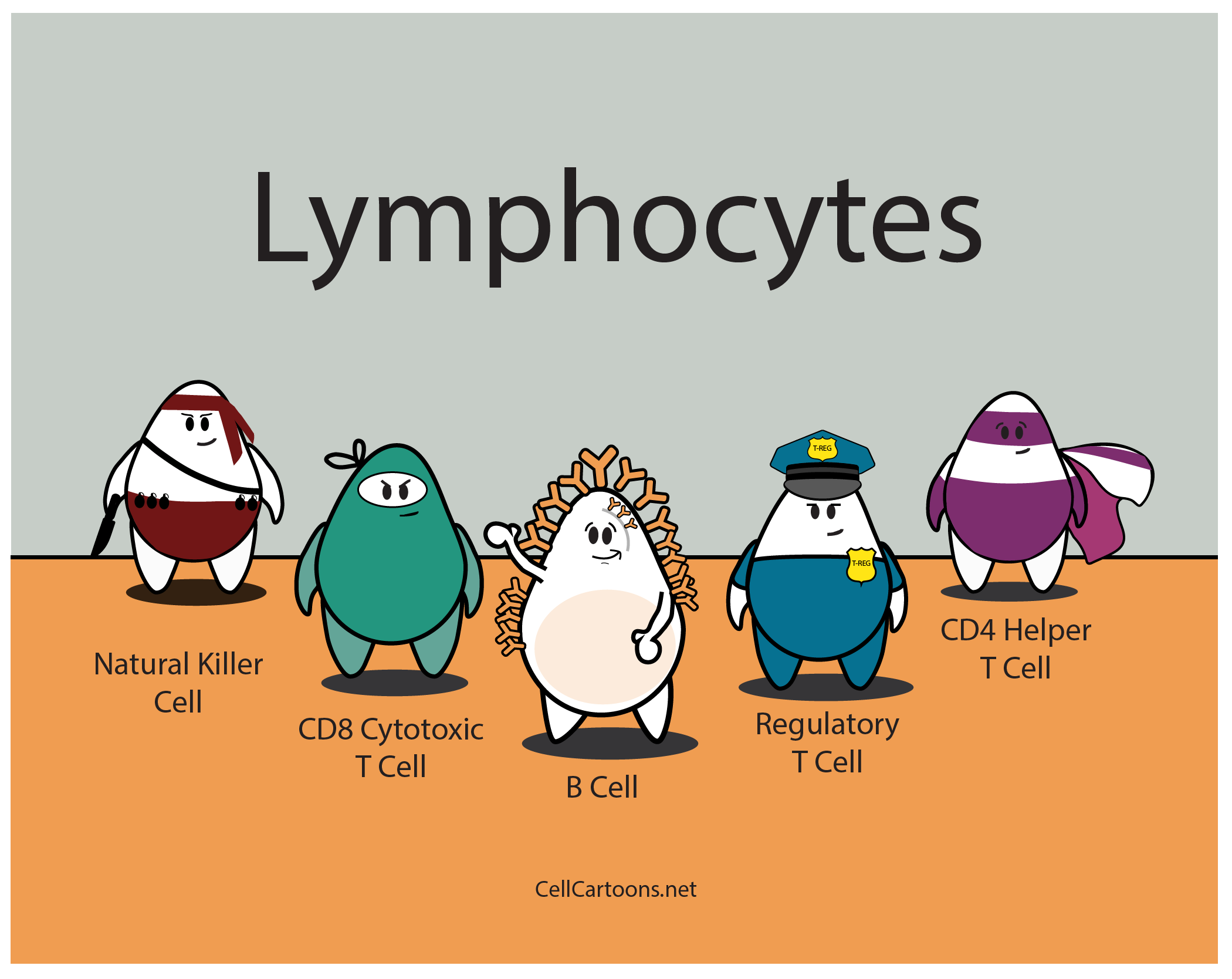A tale about our immune system superheroes
Enisa Smlatić
Early Stage Researcher 14, Ludwig-Maximilians-Universität München
August 2020
Image courtesy of Cell Cartoons, www.cellcartoons.net.
When we hear the word ‘Superheroes’ we usually think of Batman, the Avengers or The Iliad and The Odyssey. Maybe you would rather pick a modern-day, real-life hero such as your mother, or a Nobel Prize winner like Marie Curie, who revolutionized science as we know it. However, little do we reflect upon the fact that a continuous battle is being fought in our daily lives, not visible by the naked eye.
Now with the COVID-19 crisis fully ongoing, people have become much more aware of the concept of immune system, and the terms “antibody”, “herd immunity”, “immune protection” and so on have been all over the place. However, what exactly does our immune system entail? Where does it come from and how does it work? An even more compelling question might be: how can our immune system protect us from dangerous pathogens such as life-threatening viruses and be of use to fight the emerging antimicrobial resistance?
Our immune warriors have played a tremendous role in defending us from the above and their role will become even more prominent with the future rise of new, innovative immunotherapeutics. However, let us first start with straightening out the concept of innate immunity!
Once we are born, our body gets exposed to millions of bacteria and other microorganisms, some of them bad, some of them good and some nothing much. Fortunately, we are armed with a part of our immune system that can wear off a bunch of the bad microorganisms, also called ‘pathogens’. Pathogens can make you pretty sick, sometimes up to the point where your body can’t deal with them anymore and you die; think of salmonella food poisoning, hepatitis B, malaria fever, just to name a few. This first line of defence is our innate immunity, which already exists prior to infection. In other words, it is always there, watching over us. Several actors are involved in this complex system, such as neutrophils, dendritic cells, lymphocytes and monocytes that transform into macrophages. These are all quite difficult names that define several types of white blood cells, or ‘leukocytes’. If you are a healthy individual, there is nothing much to worry about, the innate immune systems will do its job. Moreover, it will grow more mature towards adulthood.
So here goes the story: On a nice Sunday afternoon in July, Julius Petri (famous microbiologist, in case you haven’t heard about him) is having a picnic in the park. Little does he realize that the meal he is enjoying contains some vegetables that haven’t been washed well. However, when a bad bacterium invades our body, such as Salmonella typhi, this will not go unnoticed! Luckily, we have some guarding cells that are hiding in our tissue, which are also called ‘sentinel cells’. The guarding cells will notice the invading microbe because microbes contain PAMPs. PAMPs is an abbreviation for ‘Pathogen-Associated Molecular Patterns’ a very long term indicating that microbes have these molecules sticking out to their surfaces that will be picked up by the guarding cells. Simply put, our body recognizes these common molecules and knows this is not something that belongs here. The guarding cells have their PPRs as armours, the ‘Pattern Recognition Receptors’. The armour of the guarding cells will recognize the invading bacterium and then they will alarm the blood vessel cells by sending them chemical signals, called cytokines. Have you ever heard of interferons and interleukins? These are examples of cytokines, which stimulate inflammation by recruiting white blood cells into the infected tissue.
This is where the real deal starts: what basically happens is that the neutrophils and monocytes will eat the microbe and then they all die. You got that correctly, our own white blood cells sacrifice themselves to protect our health! This process of self-destruction of a cell is called ‘apoptosis’. The next attack comes from the macrophage, which is a transformed super monocyte, aka ‘the Big Eater’. The macrophage eats bacteria but also eats the dead cells that were infected. It eats whatever is bad, and actually cleans up whatever is left in the tissue. The process of eating cells is called ‘phagocytosis’. (You may have noticed by now that a multitude of medical terms are derived from Greek words, so there is a logic behind it!). What we end up with is a battlefield between white blood cell soldiers and the microbial invaders, also called an inflammatory reaction. Some people barely notice anything, others might need extra medical care. Julius Petri does feel a bit ill; he has a fever and some intestinal problems. However, in a couple of days he will be in fine fettle again and ready to go back to work in the lab! The guards and soldiers of our immune system will be back on track to wear off a new invader.
Isn’t that very impressive? Aside from getting spoiled with nice presents when you are born, having an efficient native immune system is a gift for life! However, there is a catch (there always is one with biology!): even though our innate immune system soldiers offer a very quick response to an invader, the response is always the same. This can be problematic in certain cases where, for example, the microbe has invented some witty ways to evade this innate immune reaction. Therefore, we need a more specialized response. Stay tuned to get to know more on how our (complex) immune system deals with dangerous invaders.
References
1. Simon, K. A., Hollander, G. A., McMichael, A. (2015). Evolution of the immune system in humans from infancy to old age. Proceedings of the Royal Society B: Biological Sciences, 282: 20143085. http://dx.doi.org/10.1098/rspb.2014.3085.
2. Nicholson, L., B. (2016). The immune system. Essays in Biochemistry. 60, 275-301. https://doi.org/10.1042/EBC20160017.
3. The Mayo Clinic: Salmonella Infection. Retrieved July 20, 2020, from https://www.mayoclinic.org/diseases-conditions/salmonella/symptoms-causes/syc-20355329.
4. HMX Course: Fundamentals of Immunology, Lichtman A. Pillai, S. Harvard Medical School.
Recent Tweets from BactiVax
-
RT @mcclean_siobhan: Our fantastic @Bactivax meeting is all over. Great science, great chats and plenty of fun. Thanks to Rita Berisio (… https://t.co/sC7ddNvinE
-
RT @mcclean_siobhan: We had a really informative session this morning on D3 of our @BactiVax summer school: Science Communication & over… https://t.co/sj3zYNHs0h
-
RT @mcclean_siobhan: Amazing talk from Mariagrazia Pizza from @GSK who shared her extensive experience in working on Bacterial #Vaccines… https://t.co/Nm4U46hxJd
-
RT @mcclean_siobhan: Amazing day and it’s been wonderful to see the research projects of each #ESRs develop and grow. 🎉🎉🎉 @REA_research
-
RT @mcclean_siobhan: @LorenzoBossi5 was our last speaker of the day. Based at @immunxperts, he presented his work on the human immune re… https://t.co/THA1OkaxT3





